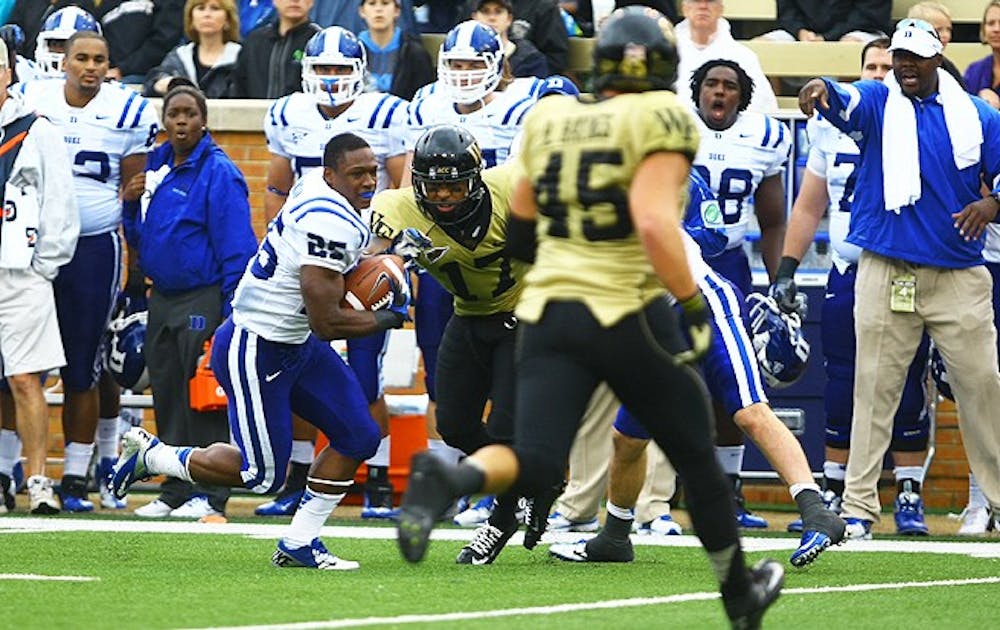The beginning of the 2012 NFL season was overshadowed by a high-profile labor dispute with its referees, creating an unusual emphasis on officiating. As faulty replacement officials altered the outcomes of games at the professional level, college football’s officiating crews are forced to make controversial decisions of their own in order to protect players against debilitating head injuries, much to the dismay of players and coaches.
One of the more noticeable adjustments the NCAA has made this season is to kickoffs, often considered one of the most dangerous plays in football. For the first time, kickoffs at the collegiate level were moved up to the 35-yard line and touchbacks were moved from the 20 to the 25-yard line to encourage players to take a touchback rather than return the kick.
A subtler rule change, however, requires a player whose helmet comes off in the course of play to leave the field for one play before returning. Although this occurs infrequently, the rule has been met with mixed reviews for slowing the game down.
“I think they thought that players weren’t wearing it strapped up or not fitting it properly, but I don’t think that’s the case,” Duke head coach David Cutcliffe said during his weekly media luncheon on Sept. 18. “The few coaches I’ve talked to about it feel like I do. It’s not a very reasonable rule. I don’t think it has anything to do with player safety, taking him out of the game.”
Little did Cutcliffe know, his team would have to deal with this rule last Saturday and the results could have been costly.
Searching for its first win against Wake Forest since 1999, freshman Jela Duncan had an opportunity to score his first career touchdown for Duke and extend his team’s lead to two scores in the process. Catching a swing pass in the flat from redshirt senior quarterback Sean Renfree in the third quarter, Duncan ran powerfully until he was met by Demon Deacon linebacker Justin Jackson, who put a big hit on Duncan and ripped off the running back’s helmet. Duncan sustained the decapitating hit, spun away and broke into the open field just before the play was called dead because his helmet came off. Even without his helmet, Duncan would have scored easily. Wake Forest was assessed 15-yard face mask penalty from the end of Duncan’s eight-yard catch.
Because the removal of Duncan’s helmet resulted from an illegal play, he was not forced to leave the field for one snap as the rule dictates. And the Blue Devils still found the back of the end zone on that drive. Luckily for Duncan, he was not robbed of his first career touchdown for a second time and notched his first collegiate score on a 17-yard scamper with 2:50 remaining in the game. Although the enforcement of this rule did not prevent the Blue Devils from winning the contest, it needs to be reexamined by the NCAA. Not only does the rule affect the flow of football games, but also could potentially endanger the same players it strives to protect.
In Georgia Tech’s 56-20 drubbing of Virginia Sept. 15, Yellow Jacket head coach Paul Johnson said in his post-game press conference that his quarterback was being targeted by the Cavalier defense. Johnson argued that Virginia’s defense was targeting quarterback Tevin Washington’s helmet in goal line situations. Washington’s helmet came off twice in scrums near the goal line, forcing the signal caller to exit the field of play both times.
The worst part is, it all makes perfect sense. If you were a college football player and had the opportunity to take out your opponent’s best player at a crucial juncture in the game, why wouldn’t you at least try?
In a game fueled by drive and aggression, college football players are now given an incentive to rip opponents’ helmets off to force them off the field. Not only does this soil the sanctity of the game, but it could also potentially result in a greater quantity of hits to the head and increase concussion risk, which is ironically what this rule is meant to prevent.
Jim Kovach, CEO and Co-Founder of Athleticode Inc., studies genetic influence on traumatic brain injuries’ susceptibility and response on a daily basis. Kovach has analyzed countless contact injuries and dished out a few hits as well. He played seven NFL seasons as a linebacker for the New Orleans Saints and San Francisco 49ers while simultaneously earning a medical degree during his offseasons from his alma mater Kentucky.
Shortly after his playing career ended, Kovach also earned a law degree from Stanford. When asked about the new NCAA rule, Kovach claimed it was designed to enhance player safety, at least in theory.
“The way it would enhance safety is if [the rule] disciplined players to snap their chin strap and keep their helmet fitted properly throughout the year—this in turn could reduce injuries,” Kovach wrote in an email to The Chronicle. “However, there is no study as far as I know that has correlated helmets that pop off with increased head injuries.”
Although Kovach said he “doesn’t see [the rule] enhancing or harming the safety of the game,” he added that many of the game’s chippier moments are not visible to the naked eye.
“In a pile there are no rules,” Kovach said. “You wouldn’t believe what goes on in there.”
The NCAA needs to examine the way it regulates the game in the name of player safety. Despite good intentions, the NCAA has failed to examine whether it is inadvertently incentivizing the types of contact it seeks to eradicate from the game.
Get The Chronicle straight to your inbox
Signup for our weekly newsletter. Cancel at any time.

